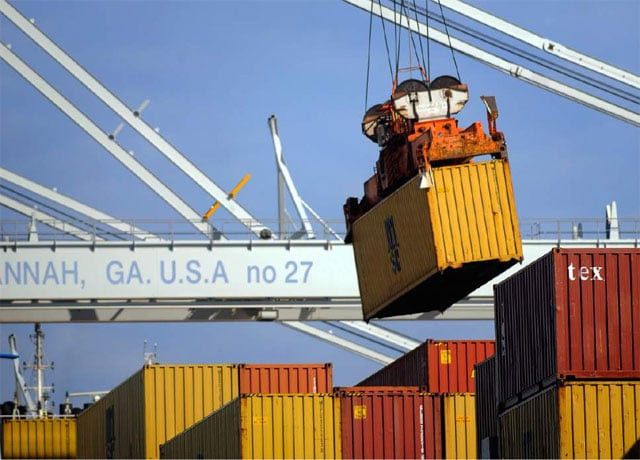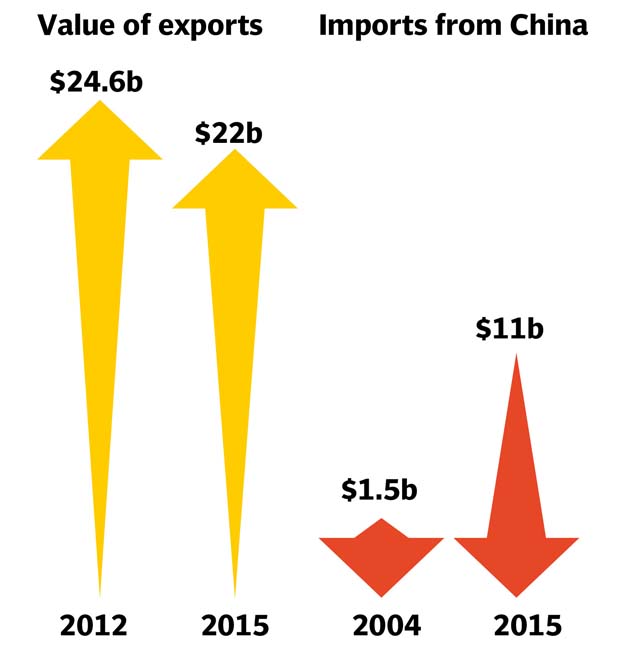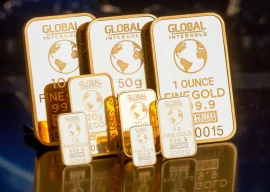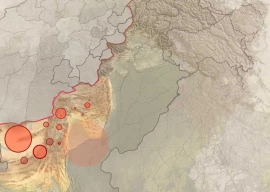
It is expected to be higher in 2016.
The State Bank of Pakistan (SBP) reports that the trade deficit from January to October was higher in 2016 than in the previous two years. The rising trade deficit coupled with the increasing external debt servicing payment is a cause of concern.
Iran stalls response to Pakistan’s FTA proposal
Data available at COMTRADE and Trademap.org shows that the value of exports declined from $24.6 billion in 2012 to $22 billion in 2015. Additionally, the value of imports was approximately $44 billion between 2011 and 2013 and increased to $47.5 billion in 2014 but later decreased to $44 billion in 2015.
Oil imports
Pakistan is heavily reliant on imported oil products, for both household and industrial consumption. The falling oil and commodity prices in the recent months was expected to reduce the trade deficit but on the contrary, trade deficit increased to its highest value.
Considering the Broad Economic Categories (BEC) by COMTRADE, there was a sharp decline in the percentage of imports of primary products, particularly in fuels and lubricants between 2004 and 2015.
If primary products are imported into Pakistan, converted to processed products and then sold to consumers, the value addition will occur within Pakistan. There has been an increase in the imports of high speed diesel oil and furnace oil since 2006. This suggests an increase in the percentage of imports of processed products, which are converted from primary to processed goods before shipment to Pakistan.
Pakistan’s import and export industries worth over $1 billion each
Although the reason for this change revolves around the structural adjustments in the petroleum industry, it exacerbates the trade deficit as the unit value of the processed products is likely to be higher than that of the primary products.
Not only are imports essential in infrastructure and industrial development but there is also likely to be a strong link between import growth and export growth, particularly if inputs are imported to produce goods of exportable quality.
Imported inputs are needed when domestic inputs are either unavailable or of a sub-standard quality. With the advent of China Pakistan Economic Corridor (CPEC), the industrial strategy must be designed such that the proliferation of imported inputs and foreign investments for the development products contributes towards industrial growth and increase in manufacturing output.
Pakistan and China
Pakistan imported more than $11 billion from China in 2015. It was the largest country of origin for the imports into Pakistan. It was followed by the United Arab Emirates, Saudi Arabia, Indonesia and the United States of America.
Imports into Pakistan are heavily concentrated in mineral products. It contributed to more than a quarter of the total imports between 2006 and 2014. It fell to 22.8% of the total imports in 2015.
Machinery, both electrical and non-electrical, was the second most imported good in 2015, followed by iron and steel and plastic articles. As the total value of imports of mineral products have fallen due to receding oil prices, the percentage contribution of other imports such as machinery has increased from 13% in 2012 to 18% in 2015.
There has been an increasing prominence of mobile phones as well as of photovoltaic cells and wind-powered generating sets in the imports into Pakistan.
China is a major global manufacturing hub and an important supplier of several capital and consumer goods. Approximately, 38% of the imports from China into Pakistan in 2015 were in machinery, both electrical and non-electrical, and mechanical appliances and 15% in base metals and another 15% in chemical products.
On the other hand, more than 57% of the imports into Pakistan from Saudi Arabia and 80% of the imports into Pakistan from United Arab Emirates in 2015 were in mineral products.

Intermediate goods constitute the highest proportion of total imports into Pakistan in 2015 at approximately 32% of the total imports. Intermediate goods commonly imported into Pakistan include fertilisers, polymers of propylene and ethylene to produce plastic articles, and intermediate goods of iron and steel as well as of organic chemicals.
About 20% of the imports are capital goods, which include electrical equipment, power-generating sets, and data processing machines.
Approximately 42% of the imports in 2015 from China were intermediate goods, 17% were consumer goods, and 39% were capital goods. Therefore, the imports of intermediate goods and capital goods increase the potential of production network between Chinese and Pakistani producers.
In summary, the import composition of Pakistan will undergo further changes as bilateral trading relationship with China is further enhanced due to increasing cooperation between the two countries under CPEC.
The writer is an Assistant Professor of Economics & Research Fellow at CBER, IBA
Published in The Express Tribune, November 28th, 2016.
Like Business on Facebook, follow @TribuneBiz on Twitter to stay informed and join in the conversation.











1728386780-0/BeFunky-collage-(38)1728386780-0-270x192.webp)






COMMENTS
Comments are moderated and generally will be posted if they are on-topic and not abusive.
For more information, please see our Comments FAQ